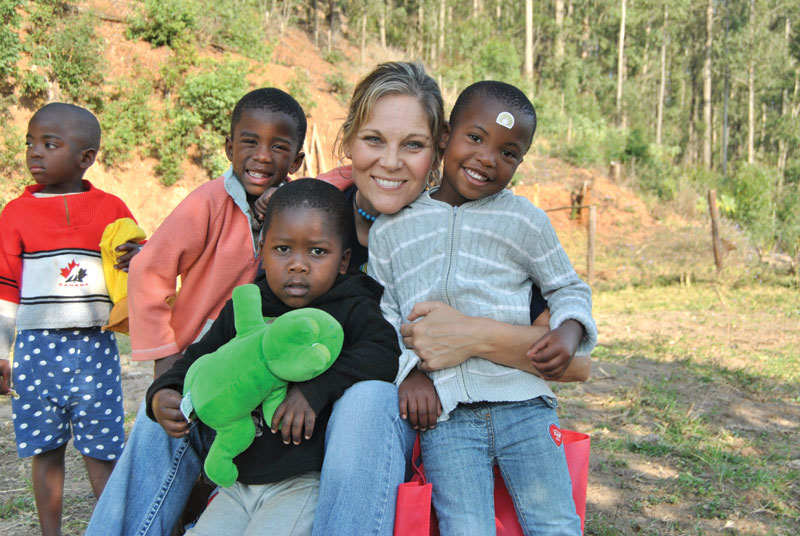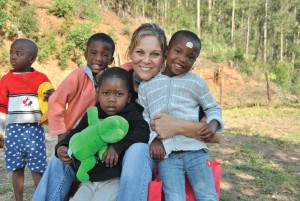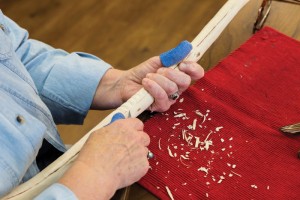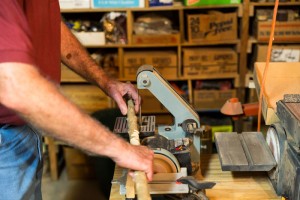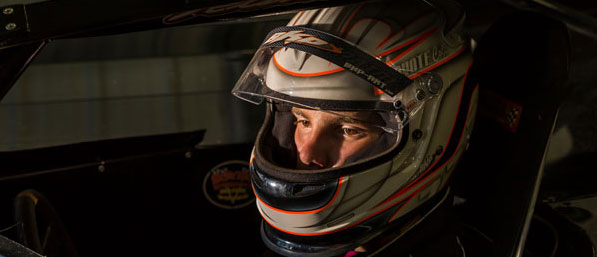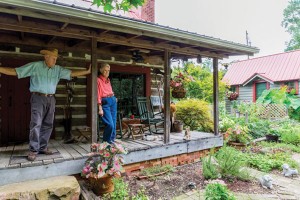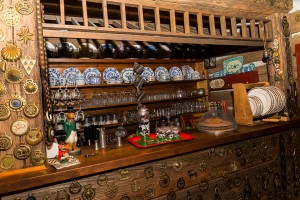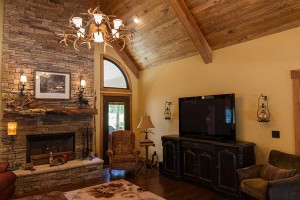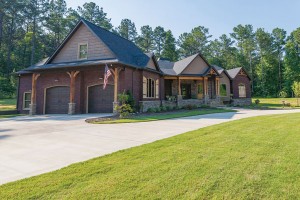Pell City’s ‘Coyote’ Cole Daffron
a force to contend with on the race track
 Story by Graham Hadley
Story by Graham Hadley
Photos by Michael Callahan
Track photos courtesy of
Kelly’s Racing Photography
Though Pell City’s William Cole Daffron can’t legally drive on the road without an adult in the car with him, he already has one national championship under his belt on the track and has his sights set on ARCA and eventually NASCAR.
With help from his family, friends, supporters and sponsors, “Coyote” Cole has been working his way up the racing ladder, starting out on the go-kart circuit and moving up to Pro Challenge 3/4-size trucks in the past year. They have a dirt track car ready and are putting together a pro late-model racecar — possibly the last step before moving on to ARCA and similar competitions.
“Cole has his eyes locked in to the ARCA series as the next step to NASCAR. He is currently running a dirt crate late-model on a limited basis to get that much-needed experience,” his father, Scott Daffron, said.
The Pell City High School student is only 15 years old — he has his learner’s permit thanks to his mother Tracy Partain mailing him the paperwork when he was at the beach. While he is learning to drive responsibly on public streets, Cole has hit speeds of well over 100 mph on the track.
Cole started racing go-karts in 2007 when he was 9 years old. His father had been racing cars off and on for years and helping other racers, with Cole often following Scott to the track to watch.
Cole said he tried out baseball, but did not like it much — he knew he wanted to get behind the wheel. The decision to start racing was mutual. Cole wanted to race and Scott wanted him to do it too, but did not want to push him.
“It was his decision. He had to want to do it. I wanted to be sure he was living his dream and not mine,” Scott said.
For Cole, the choice was simple — he wanted to race. In fact, that is his core goal, to make a career on the track.
So Scott bought a racing go-kart. These are not your run-through-the-yard domestic karts many children have. They are miniature racecars and are almost as complicated as the larger vehicles, costing in the thousands of dollars. Scott started out with a used one in case Cole decided he did not want to keep racing.
But he took to the sport like a natural — and has a room full of trophies and winner’s checks, not to mention a national-championship ring, to prove it.
Cole started racing at the Talladega Short Track in 2007, pulling a respectable third place track championship that year. The following year, he earned a track championship, and by 2009, he won both the Alabama-Mississippi Series championship, champ kart, and the Maxxis Tire national championship, flat kart.
“That first race, it was exciting, different from anything I had ever done. It was the best time I ever had,” Cole said, though he did note the national championship race was the most exciting time he has ever had.
Scott said it was during those early racing days Cole earned the nickname “Coyote” — based on the coyote character from the Roadrunner cartoons. He was racing more experienced drivers who had already made names for themselves, “and I told him if he beats those guys, he would be the Coyote. … and then he started beating them.”
As the wins kept coming, with success across the Southeast in Alabama, Mississippi, Florida, Georgia and other states, Cole stepped up to the next level with the 3/4-scale Pro Challenge trucks, graduating at the same time from dirt to asphalt, once again proving himself a natural behind the wheel.
To date, Scott said Cole has not had a Pro Challenge finish lower than fifth. Just this September, he set a new track record during qualifying at Sunny South Raceway in Grand Bay, Alabama, and went on to win the race there for the sixth time in a row.
Even before that race, the PCHS teen had already been tapped as the 2013 rookie of the year for that series and is in a “three-way battle” for second place in the national championship, he said.
Scott and Cole say they fully expect him to be in an ARCA race by 2015.
Dedication, hard work
and more than a little help
Though Cole is the one driving the car, there is a whole network of support behind him making his racing career possible.
“A lot of people don’t understand this is a full-fledged racing program,” Scott said. The go-karts cost thousands of dollars, the Pro Challenge car costs thousands more, and the dirt-track car and the pro late model cars cost in the tens of thousands — and that is just to purchase the vehicle and get it race ready. That does not include maintenance and parts — especially tires, and the transportation to and from the tracks and other expenses.
Luckily for Cole, help is in no short supply.
His grandparents, Bill and Patricia Daffron, “are probably Cole’s biggest sponsors and his biggest fans. They make sure we have what we need to race. They are very supportive,” Scott said.
In fact, it is partially because of Bill that the family got into the racing business. He left the car dealership he had been working at to start a salvage yard and body shop. It was that car-filled environment that Scott grew up in that he credits with getting him hooked on racing (and restoring vintage vehicles, but that’s another story). Though his father still runs the salvage yard, Scott handles the body shop.
It is this family-run business and its resources that form the backbone of Cole’s racing operation.
Because of his quick success at the track, Cole has already landed one sponsor — Amsoil D&S Lubrication through Dennis Crowe, which has brought in some much-needed financial support.
Then there is Carl Dieas, who helps out around the shop and can always be counted on to track down parts — sometimes from very far away and on very short notice.
“I just help out a little here and there,” Carl said, but Scott was quick to clarify exactly how important a role Carl really plays.
“He has done a round trip in 13 hours for parts that had been ordered but did not come in time. If he had not done that, we would not have been racing that weekend. It’s hard to do this without Carl,” Scott said.
Cole and his Dad also throw credit to Scott Honeycutt — Cole’s spotter during races and his “right-hand man.”
“He is the best spotter I have seen. He can talk Cole through any thing, a wreck, whatever, on the track. … But he does not try to tell Cole how to drive,” Scott said.
For all the help he receives, Cole does his part, too — aside from just driving.
Between training and maintaining his vehicles, Cole says he does not have much free time. “I come in from school and start working in the garage. We take a break around 5 and eat dinner, then come back out and work some more,” he said, adding that the races take up “just about all my weekends.”
And though he is only 15 and can’t legally drive on public streets without an adult, he is preparing for the day he gets his driver’s license, too, by building his own truck in one of the family’s garages. He has already made solid progress on putting his 2009 Chevrolet together.
The thrill of racing
For Cole, all the hard work is more than worth it when he gets out on the track and it’s all about the racing.
“The first time I won a truck race, we had been working so hard. It was the last few laps and I was in front. The spotter was telling me where the other guy was behind me on the last lap. You pray you don’t mess up, and then you win,” Cole said, emphasizing that the excitement of those moments is almost beyond description.
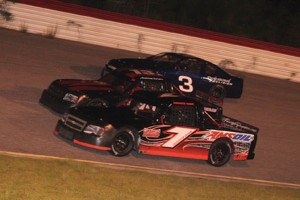 Scott shares the thrill from afar, but gets equally excited. He remembers the national championship race in fine detail. “It was my most exciting moment. Watching him come around the corners in front. Cole was breathing so hard, his mask would fog up and he would fall back. The kids kept trading the lead, then we came out ahead.”
Scott shares the thrill from afar, but gets equally excited. He remembers the national championship race in fine detail. “It was my most exciting moment. Watching him come around the corners in front. Cole was breathing so hard, his mask would fog up and he would fall back. The kids kept trading the lead, then we came out ahead.”
Along with the excitement of the race, Scott admits that, as a parent, there is also concern that something could go wrong.
“My heart feels like it is going to beat out of my chest every time somebody gets close to Cole on the track or something happens,” he said.
Luckily, Cole has not had any serious accidents to date, though he did flip a go-kart off a berm one time.
“We were coming out of a turn three wide,” Cole said. The karts got tangled up, and “I hit a berm and flipped in the air, landed on all four tires. It was pretty intense.”
“Thank God he landed on all four — there is no roll cage on those,” Scott said.
“And no seat belts,” Cole added.
Given his track record and continued winning streak, Cole said he thinks he has a solid chance of one day racing NASCAR.
His Dad agrees, but says they still have a ways to go, both as a team and Cole as a driver.
“I want to make sure he is mature enough. So far, everything has worked because we have been taking it in steps,” Scott said, pointing out that time behind the wheel is really the key to being a good driver. Right now, he wants Cole to race cars on the dirt track because, even though they can top 100 mph, the slick dirt will help prepare him for the day he races stock cars on asphalt and the tires heat up and become slick.
And, as Cole builds up his driving skills, Scott hopes to attract more attention to what they are doing, possibly even finding more sponsors and supporters.
“We are still in development. We are learning as we go along,” he said.
You can Follow “Coyote” Cole on Facebook here.
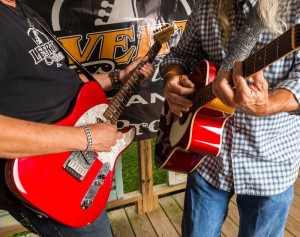 Story by Carolyn Stern
Story by Carolyn Stern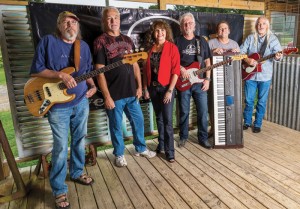 Managing to keep their day jobs, the brothers grew their audience by performing as much as possible. Randy has owned RTL Printing and Signs in Pell City for 20 years, coincidentally, the band’s direct source for its t-shirts and CD covers. Benny is retired from CenturyLink Telecommunications. They split the band’s business between Randy’s Studio 1 in Cropwell, where the recording is done on Benny’s Benjammin’ label.
Managing to keep their day jobs, the brothers grew their audience by performing as much as possible. Randy has owned RTL Printing and Signs in Pell City for 20 years, coincidentally, the band’s direct source for its t-shirts and CD covers. Benny is retired from CenturyLink Telecommunications. They split the band’s business between Randy’s Studio 1 in Cropwell, where the recording is done on Benny’s Benjammin’ label.














